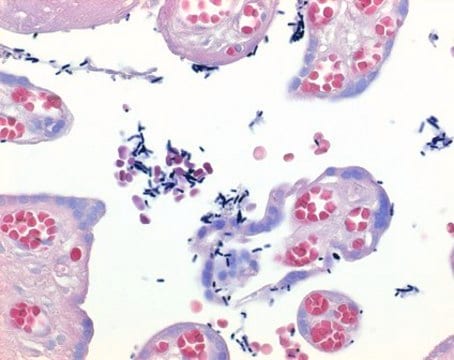1.09065
Perchloric acid solution
c(HClO₄) = 0.1 mol/l (0.1 N), in anhydrous acetic acid, reag. Ph. Eur., USP, ready-to-use volumetric solution for titration in non-aqueous media, Titriplex®
Synonim(y):
PCA
About This Item
Polecane produkty
product name
Perchloric acid, in anhydrous acetic acid, for titrations in non-aqueous media c(HClO4) = 0.1 mol/l (0.1 N), Titripur®, reag. Ph. Eur., reag. USP
agency
reag. Ph. Eur.
reag. USP
Poziom jakości
linia produktu
Titripur®
Postać
liquid
temp. samozapłonu
485 °C
jakość
Analyzed in our ISO 17025 accredited QC lab
przydatność reakcji
reaction type: Acid-base reactions
stężenie
0.1 M
metody
titration: suitable
pH
0.1 (20 °C in H2O)
temp. przejścia
flash point 40 °C
gęstość
1.06 g/cm3 at 20 °C
temp. przechowywania
15-25°C
ciąg SMILES
OCl(=O)(=O)=O
InChI
1S/ClHO4/c2-1(3,4)5/h(H,2,3,4,5)
Klucz InChI
VLTRZXGMWDSKGL-UHFFFAOYSA-N
Szukasz podobnych produktów? Odwiedź Przewodnik dotyczący porównywania produktów
Zastosowanie
- Determination of phosphorus in commercially available milk: Utilizing ion chromatography with perchloric acid deproteinization, this application provides a reliable method for analyzing phosphorus content in dairy products, essential for quality control in the food industry (Yoshikawa et al., 2024).
- Versatile ferrous oxidation-xylenol orange assay for lipoxygenase activity: This high-throughput screening technique leverages the reactivity of perchloric acid in enzymatic assays, enhancing the detection of lipoxygenase activity crucial for biotechnological applications (Chrisnasari et al., 2024).
- Nanoporous gold with microporous structure: Perchloric acid is used in the electrochemical dealloying process to create nanoporous gold structures, which are significant for their applications in catalysis and sensor technology (Li et al., 2024).
- Stability indicating reversed-phase-high-performance liquid chromatography method: This method uses perchloric acid for the analysis of pharmaceutical compounds, offering enhanced stability and reliability for drug formulation and safety checks (Chintala, 2024).
- Development of innovative methodology for determination of 6-thioguanine: By utilizing perchloric acid, this HPLC-PDA-based technique allows for precise medical diagnostics, facilitating better disease management through accurate drug monitoring (Noga et al., 2023).
Cechy i korzyści
This volumetric solution is analyzed by our calibration laboratory D-K-15185-01-00 which is accredited according to DIN EN ISO/IEC 17025 for analysis of amount-of-substance concentrations in volumetric solutions by DAkkS (Deutsche Akkreditierungsstelle - German National Accreditation Body). The accreditation certificate can be found at www.sigmaaldrich.com/ISO17025.
Opakowanie
Komentarz do analizy
Amount-of-substance concentration 0.0995 - 0.1005 mol/L
Measurement uncertainty ± 0.0003 mol/L
Traceability NIST SRM
The concentration is determined by volumetric titration and refers to 20°C.
The amount-of-substance concentration of this volumetric solution is traceable to a primary standard reference material (SRM) from the National Institute of Standards and Technology, Gaithersburg, USA (NIST SRM 84 potassium hydrogen phthalate) by means of volumetric standard potassium hydrogen phthalate (article number 1.02400), certified reference material according to ISO 17034, analyzed by our accredited calibration laboratory of Merck KGaA, Darmstadt, Germany according to DIN EN ISO/IEC 17025. The uncertainty is expressed as expanded measurement uncertainty with a coverage factor k=2 covering a confidence level of 95%.
Note: The titer is a correction factor to correct for variations of the volumetric solution, the titration equipment, the temperature and other laboratory conditions. For correct titration results it is recommended to determine a titer with the laboratory specific equipment and under laboratory specific conditions directly after opening a new bottle and at regular time intervals.
Informacje prawne
produkt powiązany
Hasło ostrzegawcze
Danger
Zwroty wskazujące rodzaj zagrożenia
Zwroty wskazujące środki ostrożności
Klasyfikacja zagrożeń
Eye Dam. 1 - Flam. Liq. 3 - Skin Corr. 1A
Kod klasy składowania
3 - Flammable liquids
Klasa zagrożenia wodnego (WGK)
WGK 1
Temperatura zapłonu (°F)
104.0 °F
Temperatura zapłonu (°C)
40 °C
Wykazy regulacyjne
Wykazy regulacyjne dotyczą głównie produktów chemicznych. Można w nich podawać ograniczoną liczbę informacji na temat produktów niechemicznych. Brak wpisu oznacza, że żaden ze składników nie znajduje się w wykazie. Użytkownik odpowiada za zagwarantowanie bezpiecznego i zgodnego z prawem stosowania produktu.
EU REACH Annex XVII (Restriction List)
Certyfikaty analizy (CoA)
Poszukaj Certyfikaty analizy (CoA), wpisując numer partii/serii produktów. Numery serii i partii można znaleźć na etykiecie produktu po słowach „seria” lub „partia”.
Masz już ten produkt?
Dokumenty związane z niedawno zakupionymi produktami zostały zamieszczone w Bibliotece dokumentów.
Klienci oglądali również te produkty
Produkty
SmartChemicals enable wireless transfer of CoA data stored on an RFID tag on the consumable bottle to the titrator, reducing effort and chance for human error. Crucial data required for the application is transmitted safely, reliably and intelligently to the instrument.
Powiązane treści
Miareczkowanie Karla Fischera określa zawartość wody w surowcach i produktach, co jest szeroko stosowaną metodą analityczną.
Karl Fischer titration determines water content in raw materials and products, a widely used analytical method.
Miareczkowanie Karla Fischera określa zawartość wody w surowcach i produktach, co jest szeroko stosowaną metodą analityczną.
Nasz zespół naukowców ma doświadczenie we wszystkich obszarach badań, w tym w naukach przyrodniczych, materiałoznawstwie, syntezie chemicznej, chromatografii, analityce i wielu innych dziedzinach.
Skontaktuj się z zespołem ds. pomocy technicznej










